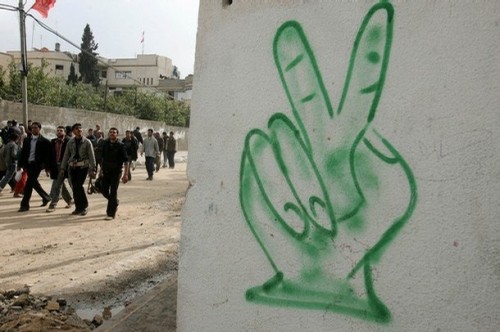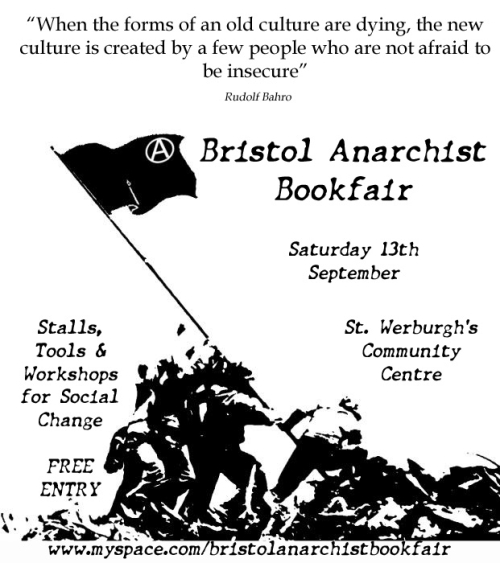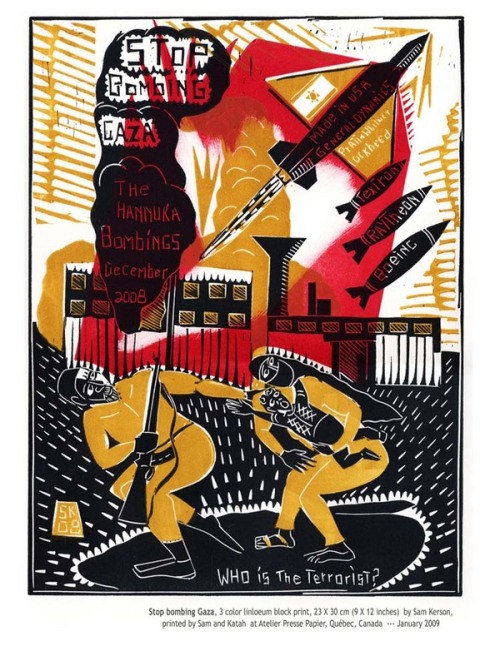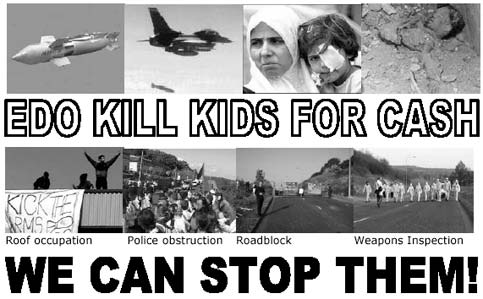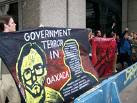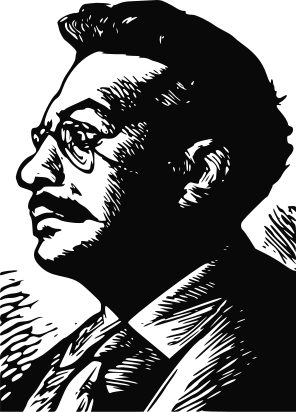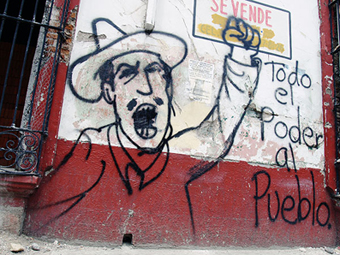Nonviolent action against NATO
On 4 April 1949, the North-Atlantic Treaty Organisation was founded with the signing of the NATO treaty. On 3 and 4 April 2009, the heads of state and government of the 26 member states and their delegations will meet in Baden Baden and Strasbourg to celebrate NATO’s 60th birthday with a NATO summit (ed.).
Since its foundation in 1949 NATO pretended to defend the so-called “free West” against the allegedly aggressive communism. If this would have been the real reason of NATO’s existence, NATO would have had to dissolve in 1991 after the end of the Warsaw Pact. But this did not happen.
During the Cold War NATO fueled for more than 40 years the arms race, which is not to legitimise the senseless actions of Russia’s armament policy. But recently released documents show: the strategic objective of NATO has been – at least for many years – the military push back of the Sowjet Union and the revision of the outcomes of the Second World War. During the Cold War NATO participated with its secret operation Gladio in repression against leftist movement with the NATO countries, and was linked also to the military coups in Greece in 19671 and in Turkey in 19802.
After the end of the Cold War and the dissolution of the Warsaw Pact NATO quickly turned itself to new tasks.
From a defence alliance to an alliance for military interventions
Already with the Rome Declaration of 1991 NATO positioned itself with a new strategy. An attack from the the East was no longer likely, instead NATO formulated as “news threats” the consequences of economic, social and political difficulties in central and eastern Europe, for which NATO had to be prepared3.
Based on this new definition the “defence alliance” became very active with a range of military interventions outside of its old area of operations. From July 1992 on NATO warships began to verify the UN arms embargo against Serbia and Montenegro in the Adriatic Sea, and later also enforced it4. This was the beginning of a development that led to the NATO military interventions first in Bosnia and later to the illegal bombardment of Yugoslavia and the NATO military intervention in Kosovo.
Today, NATO is active militarily in a variety of places: in Afghanistan since 2003 with about 60,000 soldiers, in Kosovo since 1999 with today about 16,000 soldiers, in the Mediterranean sea since October 2001 with up to 2,000 soldiers as part of Operation Active Endeavour, and in Iraq since August 2004 with a training mission with 140 soldiers. With this operation NATO in fact support and legitimises the fact created by the US and UK occupation of Iraq, and the Iraqi government created by the occupiers. The ”Anti-Pirate-operation” in front of the coast of Somalia5 was handed over to the European Union on 12 December 2008 and is now named ATALANTA6.
From these military operations the one in Afghanistan is central for NATO7. And NATO’s actions in Afghanistan are more and more aggressive and reckless. The outcomes of this occupation are more and more obvious: a brutalisation of society, more misery and more bomb deaths. From January 2006 to July 2008 more than 1,000 Afghan civilians were directly victims of NATO and US military operations8.
Via civil-military cooperation as it is practised in Afghanistan, even development aid is being integrated into the NATO war efforts. Caritas International criticised NATO in June 2008, saying that “the distribution of aid money is not linked to the real need for aid, but oriented towards the need of counter-insurgency“. At the NATO summit in Bucharest it was decided to make civil-military counter-insurgency generally the focus of present and future NATO missions.9.
Nuclear sharing
Part of the present NATO strategy is the so-called nuclear sharing – the involvement of non nuclear weapon states in NATO’s nuclear weapons. The strategy paper of 1999 stresses the requirement of “widespread participation by European Allies … in nuclear roles, in peacetime basing of nuclear forces on their territory and in command, control and consultation arrangements.” It concludes that “[t]he Alliance will therefore maintain adequate nuclear forces in Europe”10.
Because of this, US nuclear weapons are based in Germany at Büchel, in Belgium at Kleine Brogel, in the Netherlands at Volkel, in Italy at Aviano and at Ghedi-Torre, and at Incirlik in Turkey11. “Nuclear sharing” allows that in times of war pilots from a non-nuclear weapon state, which is a member of the Non-Proliferation Treaty, can use nuclear weapons, which would be a violation of the treaty12.
In addition, neither NATO, nor the nuclear weapon states within NATO – the USA, Britain and France – did rule out the first use of nuclear weapons.
A new NATO strategy: more military interventions
The NATO summit in Strasbourg and Baden Baden is not just about celebrating NATO’s 60th birthday. The main discussion will be to continue the development of NATO into an aggressive alliance for interventions, as it was started with the Rome Declaration from 1991. The summit will therefore begin a discussion on a new NATO strategy which will replace the strategy of 1999, which has been agreed during the Kosovo war, in 2010 – if everything goes well.
Important elements of such a new strategy have been proposed in a paper called “Towards a grand strategy” of five former high ranking NATO officers at the end of 2007. In this paper, the threats are even more global. Future threats are especially religious and political fundamentalism, the “dark” side of globalisation (international terrorism, organised crime and the spread of weapons of mass destruction), as well as climate change and securing access to energy resources (control of resources and conflicts as a result of climate change and climate change induced migration).
To be prepared for these challenges, NATO needs to stick with the option of first use of nuclear weapons, so the authors of the paper.13
The authors also make proposals for changes to NATO’s structure, so that NATO will be “better” able to act. They propose for NATO to abolish the principle of consensus for decisions within NATO, and propose to introduce majority decisions, which means faster actions through abolishing the veto right of member states. Especially important is the proposal to abolish national caveats in NATO operations of the kind that “plague” the Afghan campaign. In the future, NATO members that are not part of a NATO operation should not have any say about the operation.
International law will be weakened even more though the use of military force also without the authorisation of the Security Council of the United Nations, if “immediate action is needed to protect large numbers of human beings”14.
Although at present these proposal are not official proposals, it can be assumed that they will be an important part of the discussions.
While the US are already trying to build a missile defence with bases in Polen and the Czech Republic, NATO too will develop its own missile defence. This will also be one of the topics of the NATO summit in April 2009 in Strasbourg and Baden Baden.15
The further expansion of NATO, especially towards the east, will be part of the development of NATO. At the summit in Strasbourg and Baden the new NATO members Albania and Croatia will probably finally be accepted as members16. NATO also attempts in include Ukraine, Georgia, Macedonia and Bosnia and Hercegovina, and with all these countries exist bilateral partnership agreements with the long term objective of NATO membership17.
Even without war: NATO kills
Already now NATO kills even without war. The financial resources committee to military spending are no longer available for other purposes, such as social welfare, the fight against poverty or health care. And this is not just ‘peanuts’. The total of the military expenditure of all NATO members amounts to more than 70% of global military spending. Of this, the USA alone is responsible for almost 50% of global military spending, followed by France and Britain with another 10%.
According to the Stockholm based peace research institute SIPRI in the last decade global military spending increased by 45%, and amounted to 1339 billion US dollar in 2007. In Eastern Europe military spending increased by 162% between 1998 and 2007. In the view of experts, the NATO membership of formerly communist countries in Eastern Europe is the main reason for the increase in military spending in these countries, which try to bring their military structure in line with the standards in other NATO countries18.
Shut down NATO – Nonviolent action against NATO
A broad international coalition is preparing a range of protest activities for the NATO summit in Strasbourg and Baden Baden. The concept that has been agreed at an international preparatory conference in Stuttgart on 4/5 October 2008 includes:
- a counter-conference on 3 April 2009 in Straßburg;
- an international demonstration on 4 April 2009, also in Strasbourg. There will also be a feeder demonstration from Kehl on the German side;
- action camps
- actions of civil disobedience.
Several groups are preparing actions of civil disobedience for the working dinners of the foreign and defence ministers and the heads of state and governments on 3 April in Baden Baden and for the morning of the NATO summit on 4 April in Strasbourg.
Under the working title “Shut down NATO – Nonviolent Action against NATO” several nonviolent organisations – among them War Resisters’ International, Vredesactie in Belgium, the Werkstatt für gewaltfreie Aktion Baden, the Bund für soziale Verteidigung, DFG-VK and others – and individuals formed a coalition to organise an action in Strasbourg within the framework of the blockades that are being organised by a broad spectrum of groups.
The objective of the action is to block the main access routes to the summit in Strasbourg with a blockade and a “human carpet”. This will symbolise: the participants in the summit (i.e. chancellor Merkel, president Sarkozy, president Obama) will need to leave their limousines and have to walk over people lying on the floor to get to the summit. Thus they will experience the reality of 60 years of NATO: that NATO walks over corpses.
At present, the above mentioned organisations are working on the practical preparation for the action. Help is urgently needed. Take part in the action! Mobilise for the actions! Organise nonviolence training, and come to Strasbourg and Baden Baden from 1-5 April 2009.
Andreas Speck
Andreas Speck is staff at the London office of WRI and represents WRI on the International Coordinating Committee No to NATO 2009.
Contact for the action: Andreas Speck, War Resisters’ International, Email andreas@wri-irg.org, Tel +44-20-7278 4040.
This is a translated version of an article that will be published in Graswurzelrevolution February 2009
Notes
Also see the Anti-Militarist Network (AMN)
The Anti-Militarist Network was created on November the 30th during an anti-militarist gathering in Edinburgh. It aims to provide support across the network between campaigns and groups across the UK, and organise to resist the NATO Parliamentary Assembly in Edinburgh, November 2009.
The network has the following principles.
- The AMN organises along the principles of autonomy and non-heirarchy
- We embrace a diversity of tactics
- We will not condemn other peoples actions
The network makes decisions at gatherings.
http://antimilitaristnetwork.noflag.org.uk/about/
Read Full Post »

